Impact of Climate Change on the Spatio-Temporal Variation in Groundwater Storage in the Guangdong–Hong Kong–Macao Greater Bay Area
Abstract
1. Introduction
2. Materials and Methods
2.1. Study Area
2.2. Model
2.3. Datasets
2.3.1. Meteorological Forcing Data
2.3.2. Soil Properties Data
2.3.3. Plant Functional Types Data
2.3.4. GRACE Satellite Data
2.3.5. In Situ Groundwater Table Depth Data
2.3.6. In Situ SM Data
2.3.7. ESA CCI SM Data
2.4. Study Methods
2.4.1. Calculation of GWSA
2.4.2. Multiple Linear Regression
2.4.3. Mann–Kendall (MK) Test
2.4.4. Root Mean Square Error (RMSE)
2.4.5. Pearson’s Correlation Coefficient (R)
2.4.6. Mean Squared Error (MSE)
2.4.7. TSS
2.5. Experimental Design
3. Results
3.1. Spatio-Temporal Distribution of GWSA
3.2. Verification of SM
3.3. Verification of GWSA
3.4. Spatio-Temporal Variation in Precipitation, Temperature, and Evapotranspiration
3.5. Contributions of Climatic Factors to GWSA
4. Discussion
4.1. Model Performance and Uncertainty
4.2. Limitations
5. Conclusions
Author Contributions
Funding
Institutional Review Board Statement
Informed Consent Statement
Data Availability Statement
Acknowledgments
Conflicts of Interest
References
- Deng, F.; Yang, Y.; Zhao, E.-G.; Xu, N.; Li, Z.; Zheng, P.; Han, Y.; Gong, J. Urban Heat Island Intensity Changes in Guangdong–Hong Kong–Macao Greater Bay Area of China Revealed by Downscaling MODIS LST with Deep Learning. Int. J. Environ. Res. Public Health 2022, 19, 17001. [Google Scholar] [CrossRef] [PubMed]
- Cao, J.; Xia, R.; Tang, Z.; Zhao, L.; Wang, Z.; Luan, S.; Wang, S. Groundwater resources in Guangdong–Hong Kong–Macao Greater Bay Area and its development potential. Geol. China 2021, 48, 1075–1093, (In Chinese with English abstract). [Google Scholar]
- Wang, Y.; Huang, C.; Wu, G.; Wang, W. Status and Challenges of Water Resources and Supply in the Guangdong–Hong Kong–Macao Greater Bay Area (GBA) of China. Water Cycle 2022, 3, 65–70. [Google Scholar] [CrossRef]
- Cheng, L.; Song, S.; Xie, Y. Evaluation of Water Resources Utilization Efficiency in Guangdong Province Based on the DEA–Malmquist Model. Front. Environ. Sci. 2022, 10, 819693. [Google Scholar] [CrossRef]
- Wang, X.; Liu, L.; Qin, J. Integrated Model Framework for the Evaluation and Prediction of the Water Environmental Carrying Capacity in the Guangdong–Hong Kong–Macao Greater Bay Area. Ecol. Indic. 2021, 130, 108083. [Google Scholar] [CrossRef]
- Chen, Z.; Zhu, Z.; Yin, L.; Wei, S.; Deng, L. The Changing Water Quality Characteristics from Urban Drinking Water Sources in Guangdong, China. Water Resour. Manag. 2014, 29, 987–1002. [Google Scholar] [CrossRef]
- Brands, E.; Rajagopal, R.; Eleswarapu, U.; Li, P. Groundwater. Int. Encycl. Geogr. 2016, 3237–3253. [Google Scholar] [CrossRef]
- Cuthbert, M.O.; Gleeson, T.; Moosdorf, N.; Befus, K.M.; Schneider, A.; Hartmann, J.M.; Lehner, B. Global Patterns and Dynamics of Climate–Groundwater Interactions. Nat. Clim. Chang. 2019, 9, 137–141. [Google Scholar] [CrossRef]
- Cui, Q.; Shen, S.-L.; Shen, S.-L.; Wu, H.-N.; Yin, Z.-Y. Mitigation of Geohazards during Deep Excavations in Karst Regions with Caverns: A Case Study. Eng. Geol. 2015, 195, 16–27. [Google Scholar] [CrossRef]
- Lancia, M.; Su, H.W.; Tian, Y.; Xu, J.; Andrews, C.M.; Lerner, D.N.; Zheng, C. Hydrogeology of the Pearl River Delta, Southern China. J. Maps 2020, 16, 388–395. [Google Scholar] [CrossRef]
- Liu, X.; Shen, S.-L.; Cheng, W.S.; Horpibulsuk, S. Investigation of Hydraulic Parameters of a Weathered Mylonite Fault from Field Pumping Tests: A Case Study. Bull. Eng. Geol. Environ. 2016, 76, 1431–1448. [Google Scholar] [CrossRef]
- Tapley, B.D.; Bettadpur, S.; Ries, J.C.; Thompson, P.M.; Watkins, M.T. GRACE Measurements of Mass Variability in the Earth System. Science 2004, 305, 503–505. [Google Scholar] [CrossRef]
- Fan, Y.; Clark, M.R.; Lawrence, D.; Swenson, S.; Band, L.E.; Brantley, S.L.; Brooks, P.D.; Dietrich, W.D.; Flores, A.N.; Grant, G.E.; et al. Hillslope Hydrology in Global Change Research and Earth System Modeling. Water Resour. Res. 2019, 55, 1737–1772. [Google Scholar] [CrossRef]
- Ozdogan, M.; Rodell, M.; Beaudoing, H.K.; Toll, D.G. Simulating the Effects of Irrigation over the United States in a Land Surface Model Based on Satellite-Derived Agricultural Data. J. Hydrometeorol. 2010, 11, 171–184. [Google Scholar] [CrossRef]
- Xie, Z.; Liu, S.; Zeng, Y.; Gao, J.; Qin, P.; Jia, B.; Xie, J.; Liu, B.; Li, R.; Wang, Y.; et al. A High-Resolution Land Model with Groundwater Lateral Flow, Water Use, and Soil Freeze-Thaw Front Dynamics and Its Applications in an Endorheic Basin. J. Geophys. Res. Atmos. 2018, 123, 7204–7222. [Google Scholar] [CrossRef]
- Long, D.; Longuevergne, L.; Scanlon, B.R. Uncertainty in evapotranspiration from land surface modeling, remote sensing, and GRACE satellites. Water Resour. Res. 2014, 50, 1131–1151. [Google Scholar] [CrossRef]
- Scanlon, B.R.; Zhang, Z.; Reedy, R.C.; Pool, D.R.; Save, H.; Long, D.; Chen, J.; Wolock, D.M.; Conway, B.; Winester, D. Hydrologic implications of GRACE satellite data in the Colorado River Basin. Water Resour. Res. 2015, 51, 9891–9903. [Google Scholar] [CrossRef]
- Bhanja, S.N.; Mukherjee, A.; Ganguly, S.; Velicogna, I.; Famiglietti, J.S. Validation of GRACE based groundwater storage anomaly using in-situ groundwater level measurements in India. J. Hydrol. 2016, 543, 729–738. [Google Scholar] [CrossRef]
- Liu, M.; Pei, H.; Shen, Y. Evaluating dynamics of GRACE groundwater and its drought potential in Taihang Mountain Region, China. J. Hydrol. 2022, 612, 128156. [Google Scholar] [CrossRef]
- Alghafli, K.; Shi, X.; Sloan, W.; Shamsudduha, M.; Tang, Q.; Sefelnasr, A.; Ebraheem, A.A. Groundwater recharge estimation using in-situ and GRACE observations in the eastern region of the United Arab Emirates. Sci. Total Environ. 2023, 867, 161489. [Google Scholar] [CrossRef] [PubMed]
- Feng, W.; Zhong, M.; Lemoine, J.; Biancale, R.; Hsu, H.; Xia, J. Evaluation of groundwater depletion in North China using the Gravity Recovery and Climate Experiment (GRACE) data and ground-based measurements. Water Resour. Res. 2013, 49, 2110–2118. [Google Scholar] [CrossRef]
- Feng, W.; Shum, C.K.; Zhong, M.; Pan, Y. Groundwater Storage Changes in China from Satellite Gravity: An Overview. Remote Sens. 2018, 10, 674. [Google Scholar] [CrossRef]
- Rateb, A.; Scanlon, B.R.; Pool, D.R.; Sun, A.Y.; Zhang, Z.; Chen, J.; Clark, B.C.; Faunt, C.C.; Haugh, C.J.; Hill, M.C.; et al. Comparison of Groundwater Storage Changes from GRACE Satellites with Monitoring and Modeling of Major U.S. Aquifers. Water Resour. Res. 2020, 56, e2020WR027556. [Google Scholar] [CrossRef]
- Rodell, M.; Velicogna, I.; Famiglietti, J.S. Satellite-based estimates of groundwater depletion in India. Nature 2009, 460, 999–1002. [Google Scholar] [CrossRef]
- Bhanja, S.N.; Zhang, X.; Wang, J. Estimating long-term groundwater storage and its controlling factors in Alberta, Canada. Hydrol. Earth Syst. Sci. 2018, 22, 6241–6255. [Google Scholar] [CrossRef]
- McGuire, V.L. Water-Level Changes in the High Plains Aquifer, Predevelopment to 2009, 2007–2008, and 2008–2009, and Change in Water in Storage, Predevelopment to 2009; U.S. Geological Survey: Reston, VA, USA, 2011. [Google Scholar]
- Feng, X.; Zeng, Z.; He, M. A 20-year vegetation cover change and its response to climate factors in the Guangdong–Hong Kong–Macao Greater Bay Area under the background of climate change. Front. Ecol. Evol. 2023, 10, 1080734. [Google Scholar] [CrossRef]
- Huang, G.; Sun, J.; Zhang, Y.; Jing, J.; Liu, J. Distribution of Arsenic in Sewage Irrigation Area of Pearl River Delta, China. J. Earth Sci. 2011, 22, 396–410. [Google Scholar] [CrossRef]
- Lawrence, D.; Fisher, R.; Koven, C.D.; Oleson, K.W.; Swenson, S.; Bonan, G.B.; Collier, N.; Ghimire, B.; Van Kampenhout, L.; Kennedy, D.P.; et al. The Community Land Model Version 5: Description of New Features, Benchmarking, and Impact of Forcing Uncertainty. J. Adv. Model. Earth Syst. 2019, 11, 4245–4287. [Google Scholar] [CrossRef]
- Wang, L.; Xie, Z.; Jia, B.; Wang, Y.; Li, R.; Xie, J.; Chen, S.; Qin, P.; Shi, C. Recent Progress in the Land Surface Process Studies: A Case Study of CASLSM. Plateau Meteorol. 2021, 40, 1347–1363. [Google Scholar]
- Peng, Q.; Jia, B.; Lai, X.; Wang, L.; Huang, Q. Characteristics of near-surface soil freeze–thaw status using high resolution CLM5.0 simulations on the Tibetan Plateau. Atmos. Sci. Lett. 2023. [CrossRef]
- Dingman, S.L. Physical Hydrology, 2nd ed.; Prentice Hall: Upper Saddle River, NJ, USA, 2002. [Google Scholar]
- He, J.; Yang, K.; Tang, W.; Lu, H.; Qin, J.; Chen, Y.; Li, X. The first high-resolution meteorological forcing dataset for land process studies over China. Sci. Data 2020, 7, 25. [Google Scholar] [CrossRef]
- Yang, K.; He, J.; Tang, W.; Qin, J.; Cheng, C.C. On downward shortwave and longwave radiations over high altitude regions: Observation and modeling in the Tibetan Plateau. Agric. For. Meteorol. 2010, 150, 38–46. [Google Scholar] [CrossRef]
- Yang, K.; He, J. China Meteorological Forcing Dataset (1979–2018). A Big Earth Data Platform for Three Poles; National Tibetan Plateau Data Center: Beijing, China, 2019. [Google Scholar]
- Shangguan, W.; Dai, Y.; Liu, B.; Zhu, A.; Duan, Q.; Wu, L.; Ji, D.; Liang, X.; Yuan, H.; Zhang, Q.; et al. A China data set of soil properties for land surface modeling. J. Adv. Model. Earth Syst. 2013, 5, 212–224. [Google Scholar] [CrossRef]
- Liu, J.; Yang, Z.; Jia, B.; Wang, L.; Wang, P.; Zheng-Hui, X.; Shi, C. Elucidating Dominant Factors Affecting Land Surface Hydrological Simulations of the Community Land Model over China. Adv. Atmos. Sci. 2022, 40, 235–250. [Google Scholar] [CrossRef]
- Shangguan, W.; Dai, Y.; Liu, B.; Liang, X.; Yuan, H. A soil particle-size distribution dataset for regional land and climate modelling in China. Geoderma 2012, 171–172, 85–91. [Google Scholar] [CrossRef]
- Ran, Y.; Li, X. Plant Functional Types Map in China (1 km). A Big Earth Data Platform for Three Poles; National Tibetan Plateau Data Center: Beijing, China, 2019. [Google Scholar]
- Bonan, G.B.; Levis, S.; Kergoat, L.; Oleson, K.W. Landscapes as patches of plant functional types: An integrating concept for climate and ecosystem models. Glob. Biogeochem. Cycles 2002, 16, 5–23. [Google Scholar] [CrossRef]
- Ran, Y.; Li, X.; Lu, L. China Land Cover Classification at 1 km Spatial Resolution Based on a Multi-Source Data Fusion Approach. Adv. Earth Sci. 2009, 24, 192–203. [Google Scholar]
- Ran, Y.; Li, X.; Lu, L.; Li, Z.B. Large-scale land cover mapping with the integration of multi-source information based on the Dempster–Shafer theory. Int. J. Geogr. Inf. Sci. 2012, 26, 169–191. [Google Scholar] [CrossRef]
- Ran, Y.; Ma, H. 1 km Plant Functional Types Map over China in 2000. Remote Sens. Technol. Appl. 2016, 31, 827–832. [Google Scholar]
- Pie, N.; Bettadpur, S.; Tamisiea, M.E.; Krichman, B.; Save, H.; Poole, S.; Nagel, P.; Kang, Z.; Jacob, G.; Ellmer, M.; et al. Time Variable Earth Gravity Field Models from the First Spaceborne Laser Ranging Interferometer. J. Geophys. Res. Solid Earth 2021, 126, e2021JB022392. [Google Scholar] [CrossRef] [PubMed]
- Save, H.; Bettadpur, S.; Tapley, B.D. High-resolution CSR GRACE RL05 mascons. J. Geophys. Res. Solid Earth 2016, 121, 7547–7569. [Google Scholar] [CrossRef]
- Save, H. CSR GRACE and GRACE-FO RL06 Mascon Solutions v02. 2020. Available online: https://www2.csr.utexas.edu/grace/RL06_mascons.html (accessed on 4 July 2023).
- Lancia, M.; Yao, Y.; Andrews, C.M.; Wang, X.; Kuang, X.; Ni, J.; Gorelick, S.M.; Scanlon, B.R.; Wang, Y.; Zheng, C. The China groundwater crisis: A mechanistic analysis with implications for global sustainability. Sustain. Horiz. 2022, 4, 100042. [Google Scholar] [CrossRef]
- Preimesberger, W.; Scanlon, T.; Su, C.; Gruber, A.; Dorigo, W. Homogenization of Structural Breaks in the Global ESA CCI Soil Moisture Multisatellite Climate Data Record. IEEE Trans. Geosci. Remote Sens. 2021, 59, 2845–2862. [Google Scholar] [CrossRef]
- Khorrami, B.; Ali, S.; Gunduz, O. Investigating the Local-Scale Fluctuations of Groundwater Storage by Using Downscaled GRACE/GRACE-FO JPL Mascon Product Based on Machine Learning (ML) Algorithm. Water Resour. Manag. 2023, 37, 3439–3456. [Google Scholar] [CrossRef]
- Liu, R.; Zou, R.; Li, J.; Zhang, C.; Zhao, B.; Zhang, Y. Vertical Displacements Driven by Groundwater Storage Changes in the North China Plain Detected by GPS Observations. Remote Sens. 2018, 10, 259. [Google Scholar] [CrossRef]
- Rahaman, M.; Thakur, B.; Kalra, A.; Ahmad, S. Modeling of GRACE-Derived Groundwater Information in the Colorado River Basin. Hydrology 2019, 6, 19. [Google Scholar] [CrossRef]
- Sakumura, C.; Bettadpur, S.; Bruinsma, S. Ensemble prediction and intercomparison analysis of GRACE time-variable gravity field models. Geophys. Res. Lett. 2014, 41, 1389–1397. [Google Scholar] [CrossRef]
- Luo, X.; Jia, B.; Lai, X. Quantitative analysis of the contributions of land use change and CO2 fertilization to carbon use efficiency on the Tibetan Plateau. Sci. Total Environ. 2020, 728, 138607. [Google Scholar] [CrossRef]
- Wu, W.; Lo, M.; Wada, Y.; Famiglietti, J.S.; Reager, J.T.; Yeh, P.J.; Ducharne, A.; Yang, Z. Divergent effects of climate change on future groundwater availability in key mid-latitude aquifers. Nat. Commun. 2020, 11, 3710. [Google Scholar] [CrossRef]
- Mann, H. Non-parametric tests against trend. Econometrica 1945, 13, 245–259. [Google Scholar] [CrossRef]
- Kendall, M.G. Rank Correlation Methods. Biometrika 1957, 44, 298. [Google Scholar] [CrossRef]
- Sang, Y.-F.; Wang, Z.; Liu, C. Comparison of the MK Test and EMD Method for Trend Identification in Hydrological Time Series. J. Hydrol. 2014, 510, 293–298. [Google Scholar] [CrossRef]
- Wang, A.; Kong, X.; Chen, Y.; Ma, X. Evaluation of Soil Moisture in CMIP6 Multimodel Simulations over Conterminous China. J. Geophys. Res. Atmos. 2022, 127, e2022JD037072. [Google Scholar] [CrossRef]
- Qiao, L.; Zuo, Z.; Xiao, D. Evaluation of Soil Moisture in CMIP6 Simulations. J. Clim. 2022, 35, 779–800. [Google Scholar] [CrossRef]
- Pham, Q.B.; Kumar, M.; Di Nunno, F.; Elbeltagi, A.; Granata, F.; Islam, A.R.M.T.; Pal, S.; Nguyen, X.; Ahmed, A.; Anh, D.T. Groundwater level prediction using machine learning algorithms in a drought-prone area. Neural Comput. Appl. 2022, 34, 10751–10773. [Google Scholar] [CrossRef]
- Rabinowitz, L.; Rice, J.A. Mathematical Statistics and Data Analysis. Technometrics 1989, 31, 390. [Google Scholar] [CrossRef]
- Taylor, K.E. Summarizing Multiple Aspects of Model Performance in a Single Diagram. J. Geophys. Res. 2001, 106, 7183–7192. [Google Scholar] [CrossRef]
- Althoff, D.; Rodrigues, L.N. Goodness-of-Fit Criteria for Hydrological Models: Model Calibration and Performance Assessment. J. Hydrol. 2021, 600, 126674. [Google Scholar] [CrossRef]
- Huang, Z.; Yeh, P.J.; Jiao, J.J.; Luo, X.; Pan, Y.; Long, Y.; Zhang, C.; Zheng, L. A New Approach for Assessing Groundwater Recharge by Combining GRACE and Baseflow with Case Studies in Karst Areas of Southwest China. Water Resour. Res. 2023, 59, e2022WR032091. [Google Scholar] [CrossRef]
- Tang, Q.; Gao, H.; Yeh, P.J.; Oki, T.; Su, F.; Lettenmaier, D.P. Dynamics of Terrestrial Water Storage Change from Satellite and Surface Observations and Modeling. J. Hydrometeorol. 2010, 11, 156–170. [Google Scholar] [CrossRef]
- Swenson, S.; Wahr, J. Estimating signal loss in regularized GRACE gravity field solutions. Geophys. J. Int. 2011, 185, 693–702. [Google Scholar] [CrossRef]
- Landerer, F.W.; Swenson, S. Accuracy of scaled GRACE terrestrial water storage estimates. Water Resour. Res. 2012, 48, W04531. [Google Scholar] [CrossRef]
- Condon, L.E.; Markovich, K.H.; Kelleher, C.; McDonnell, J.J.; Ferguson, G.; McIntosh, J. Where Is the Bottom of a Watershed? Water Resour. Res. 2020, 56, e2019WR026010. [Google Scholar] [CrossRef]
- Xu, F.; Yuyan, Z.; Zhao, L. Spatial and temporal variability in extreme precipitation in the Pearl River Basin, China from 1960 to 2018. Int. J. Climatol. 2021, 42, 797–816. [Google Scholar] [CrossRef]
- Chen, J.; Wilson, C.R.; Li, J.; Zhang, Z. Reducing Leakage Error in GRACE-Observed Long-Term Ice Mass Change: A Case Study in West Antarctica. J. Geod. 2015, 89, 925–940. [Google Scholar] [CrossRef]
- Tripathi, V.; Groh, A.; Horwath, M.; Ramsankaran, R. Scaling Methods of Leakage Correction in GRACE Mass Change Estimates Revisited for the Complex Hydro-Climatic Setting of the Indus Basin. Hydrol. Earth Syst. Sci. 2022, 26, 4515–4535. [Google Scholar] [CrossRef]
- Scanlon, B.R.; Zhang, Z.; Save, H.; Sun, A.Y.; Schmied, H.M.; Van Beek, L.P.H.; Wiese, D.; Wada, Y.; Long, D.; Reedy, R.C.; et al. Global models underestimate large decadal declining and rising water storage trends relative to GRACE satellite data. Proc. Natl. Acad. Sci. USA 2018, 115, E1080–E1089. [Google Scholar] [CrossRef]
- Khan, U.; Faheem, H.; Jiang, Z.; Wajid, M.; Younas, M.; Zhang, B. Integrating a GIS-Based Multi-Influence Factors Model with Hydro-Geophysical Exploration for Groundwater Potential and Hydrogeological Assessment: A Case Study in the Karak Watershed, Northern Pakistan. Water. 2021, 13, 1255. [Google Scholar] [CrossRef]
- Zhang, B.; Zeng, F.; Wei, X.; Khan, U.; Zou, Y. Three-Dimensional Hierarchical Hydrogeological Static Modeling for Groundwater Resource Assessment: A Case Study in the Eastern Henan Plain, China. Water 2022, 14, 1651. [Google Scholar] [CrossRef]
- Gödeke, S.; Malik, O.A.; Lai, D.T.C.; Bretzler, A.; Schirmer, M.; Mansor, N.N. Water Quality Investigation in Brunei Darussalam: Investigation of the Influence of Climate Change. Environ. Earth Sci. 2020, 79, 419. [Google Scholar] [CrossRef]
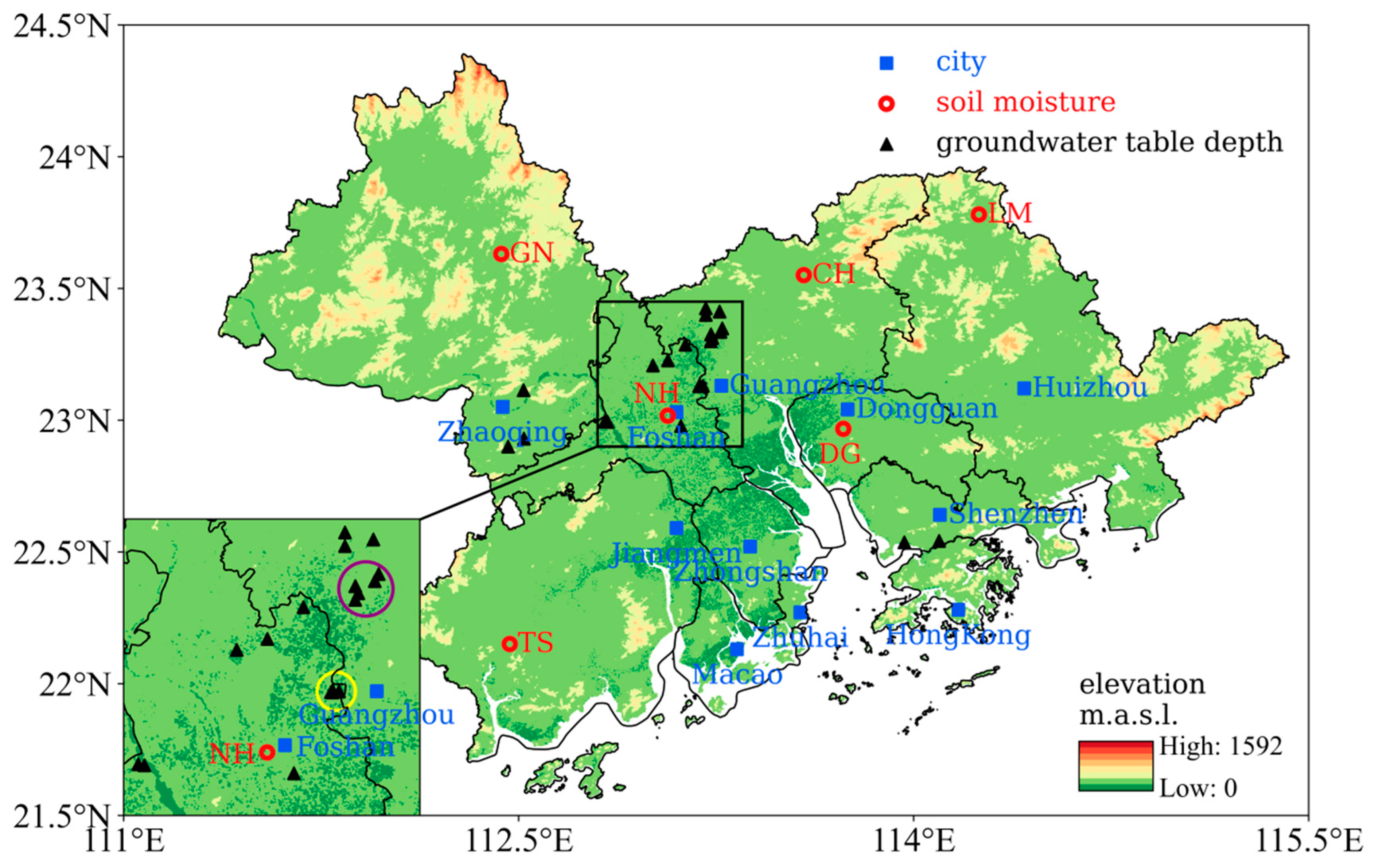
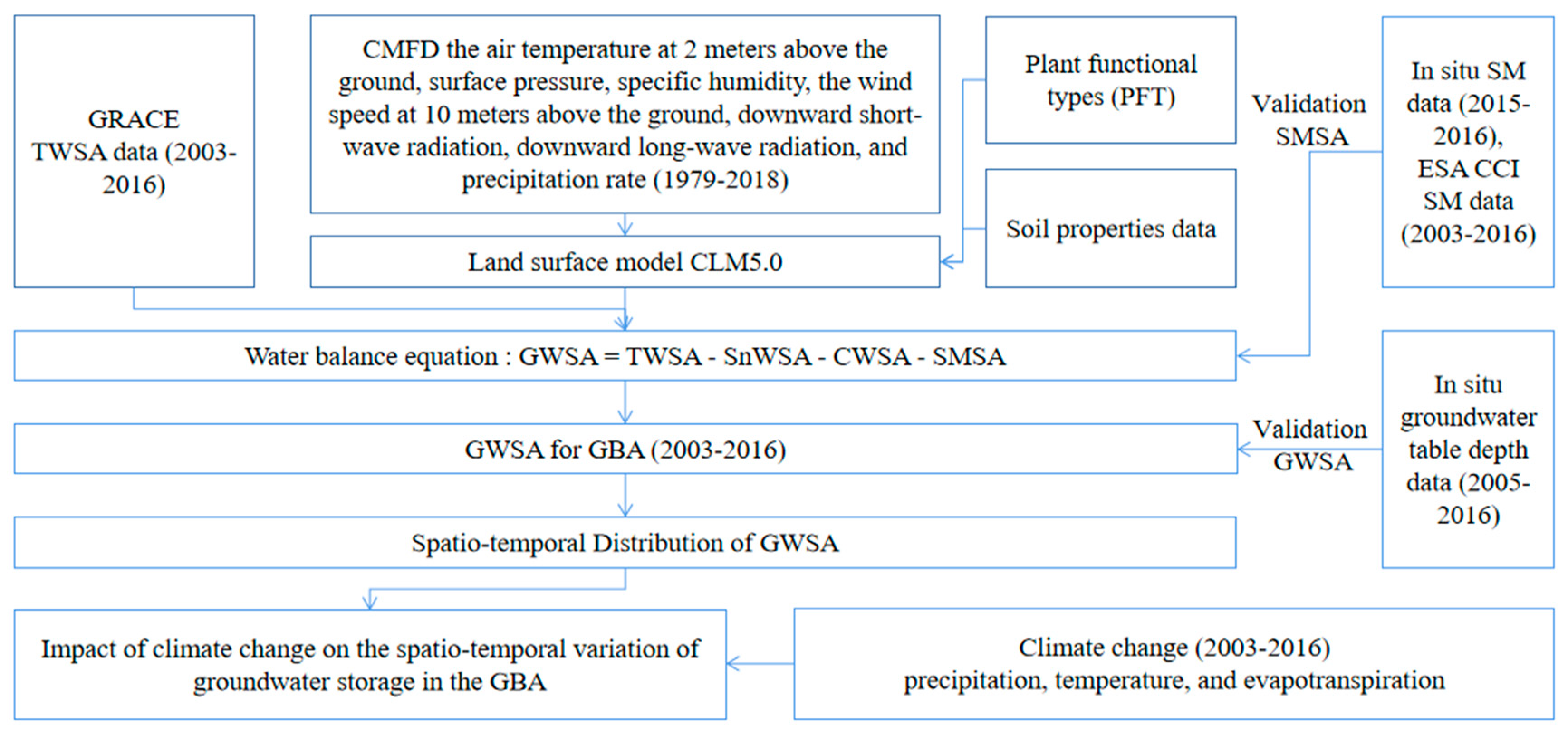
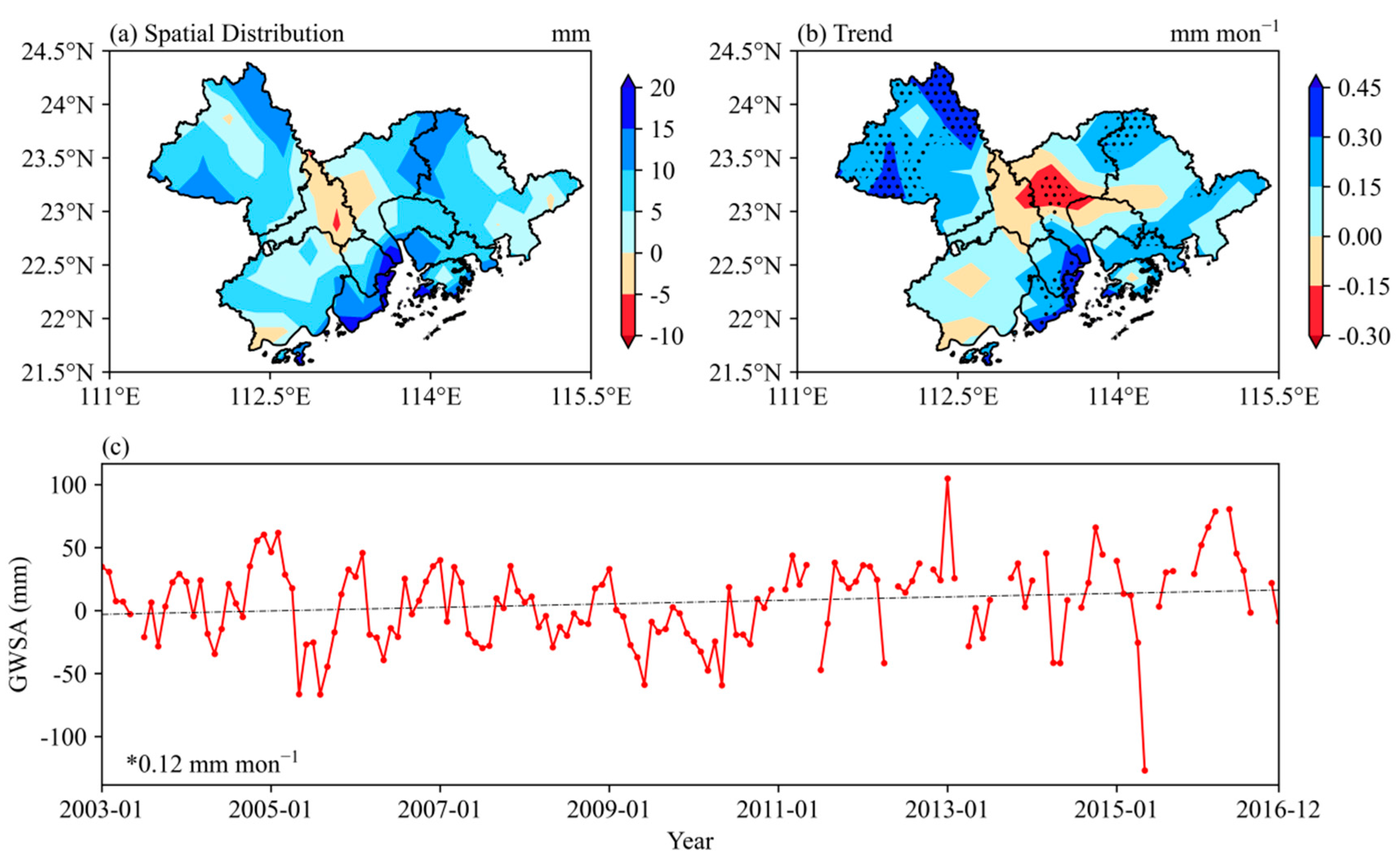
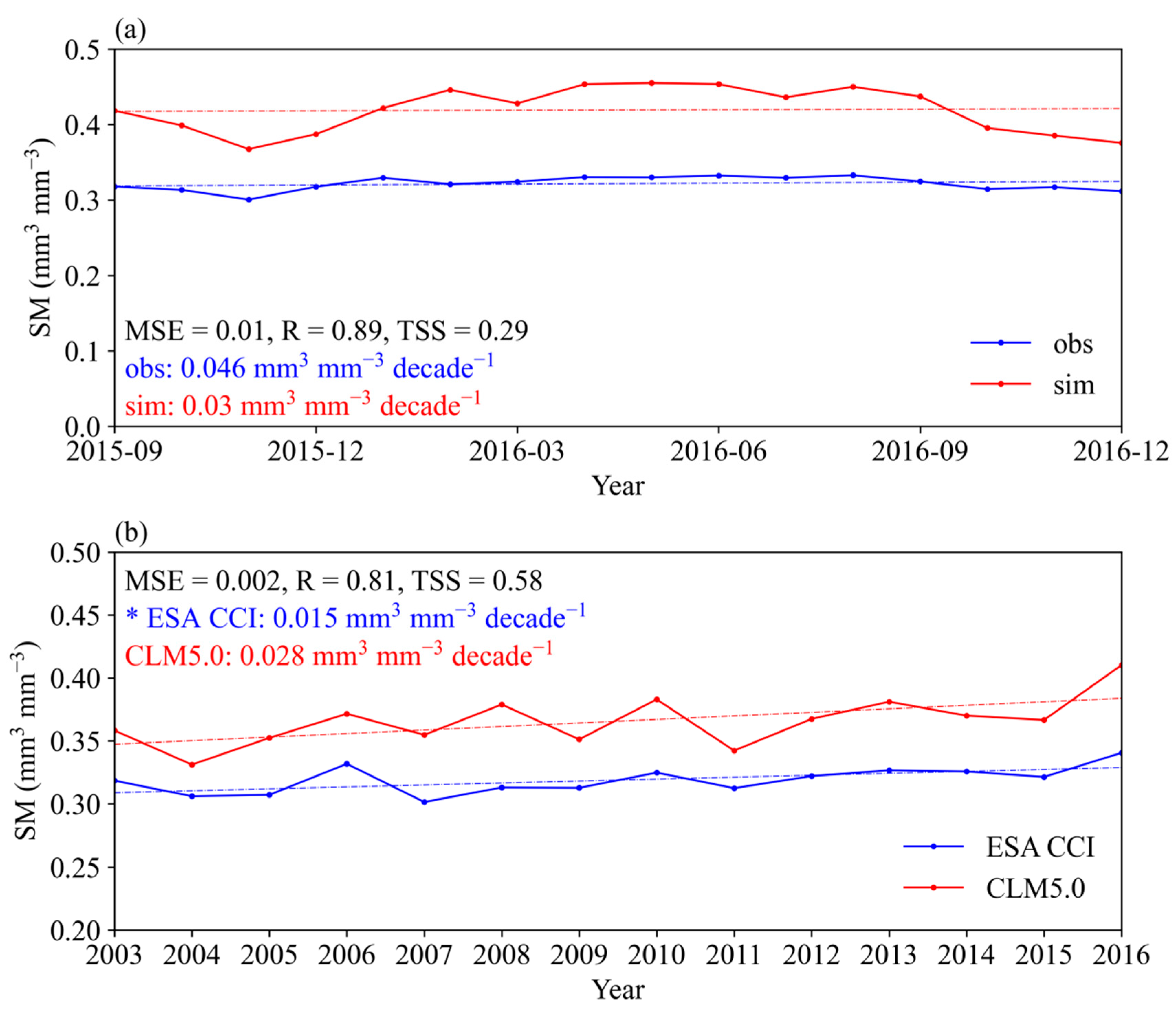
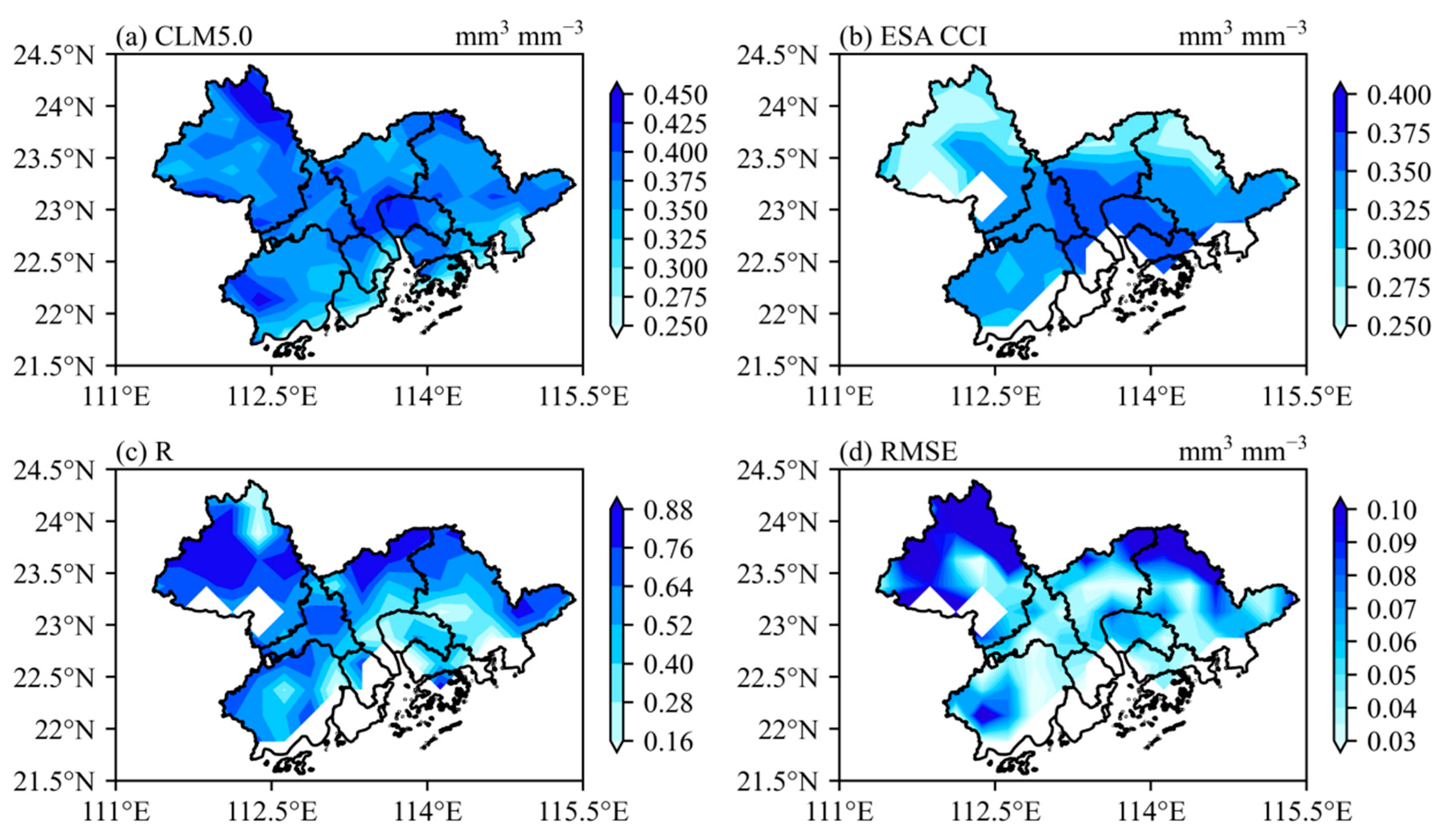
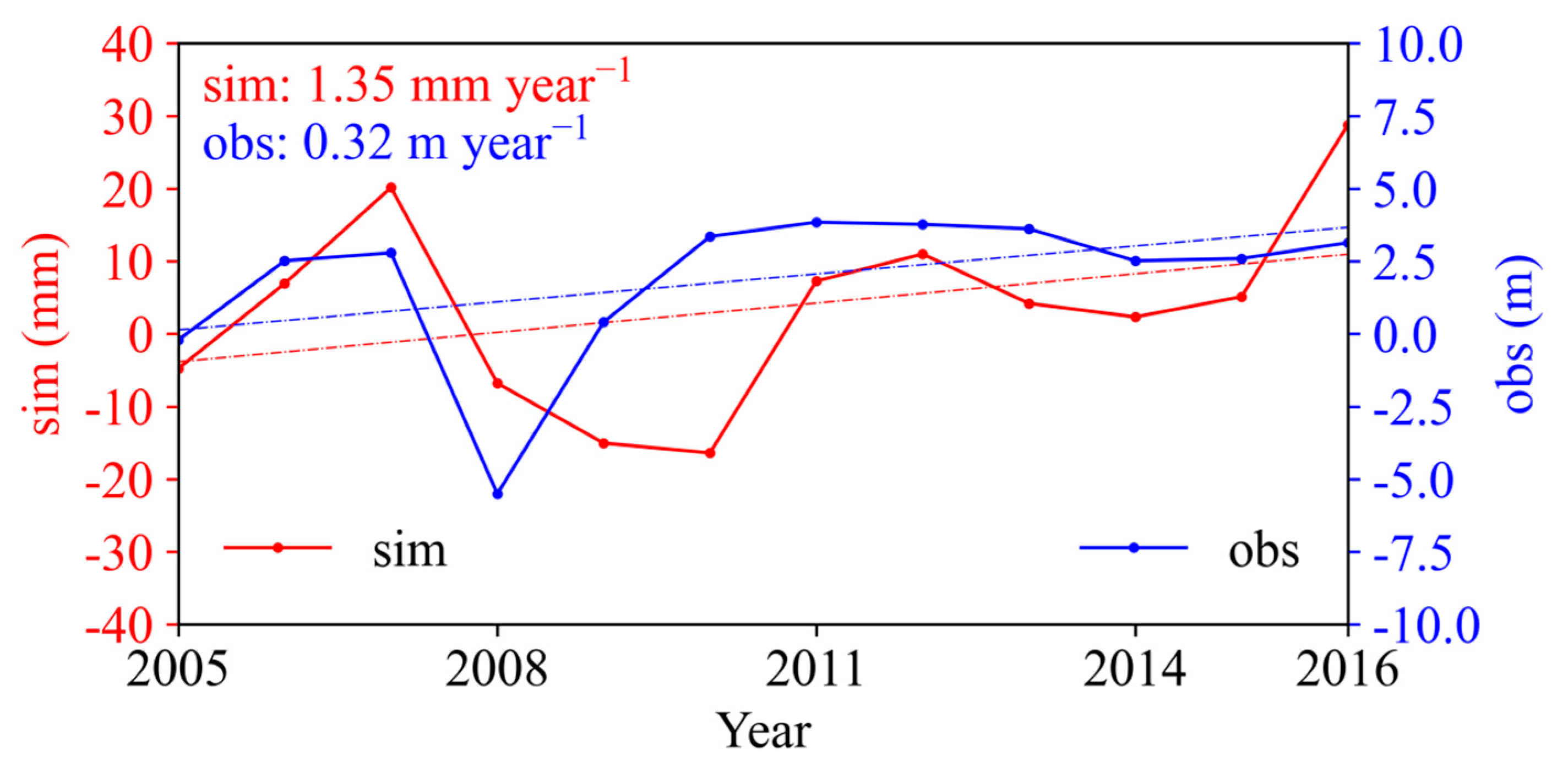
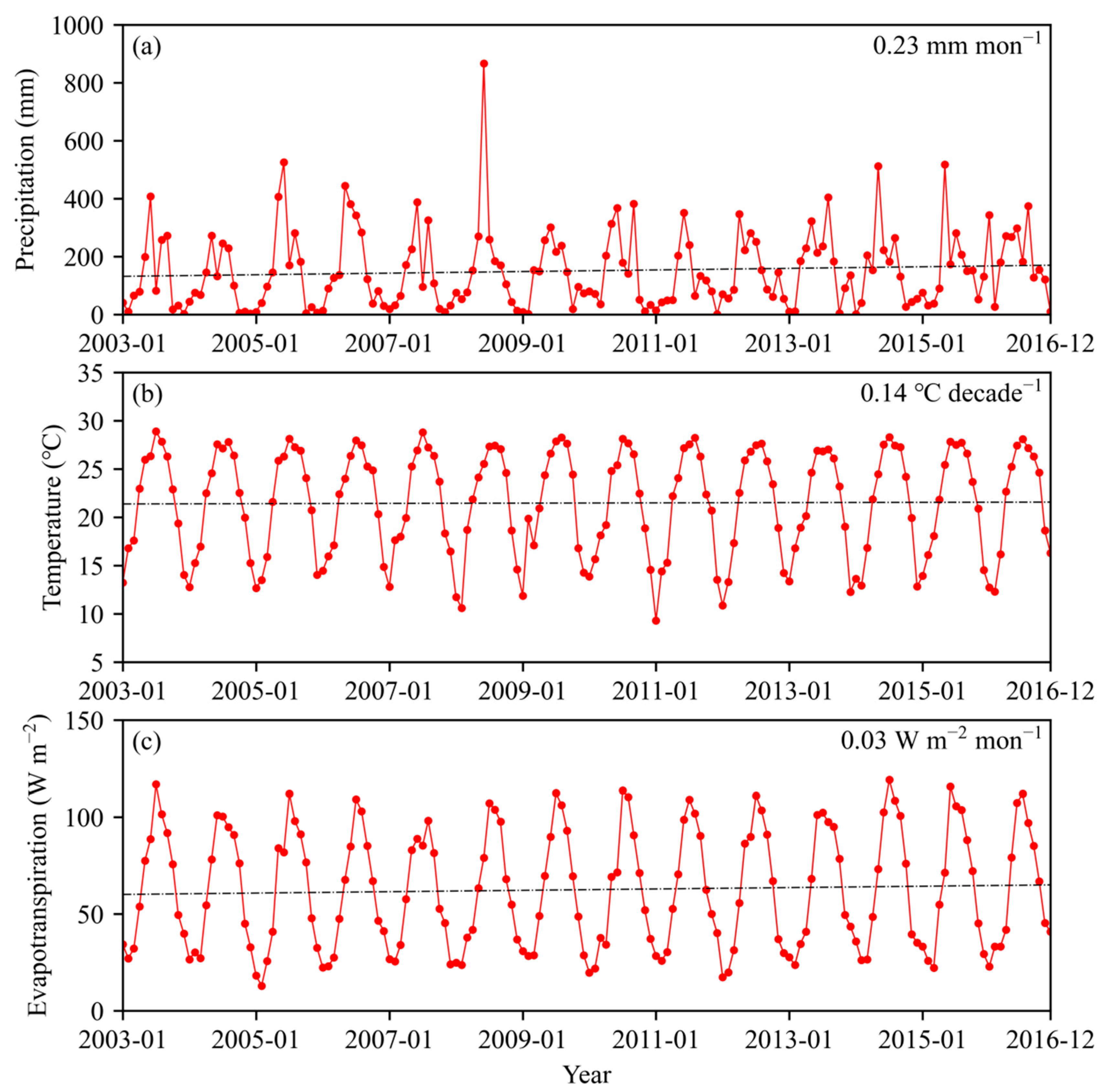
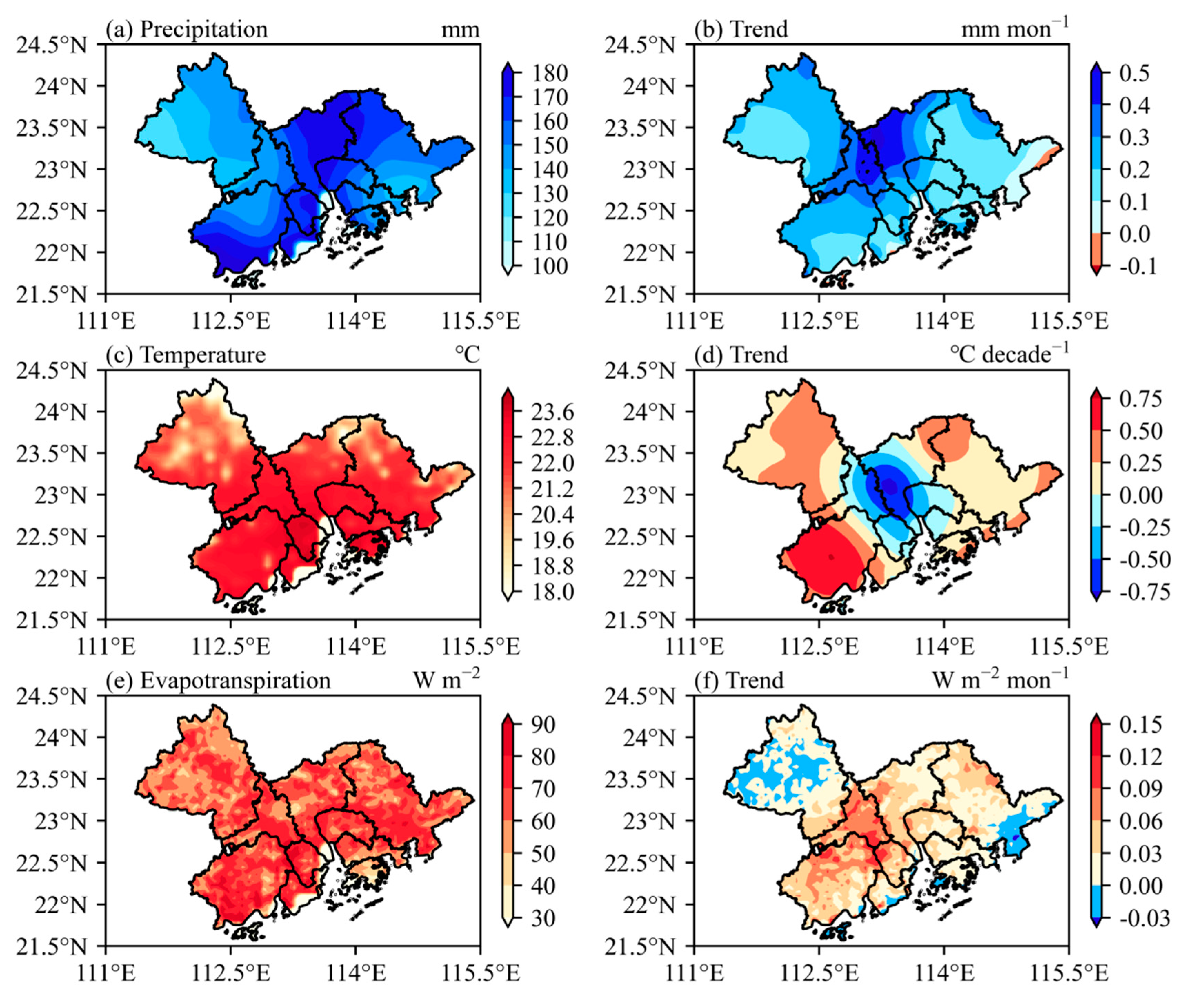
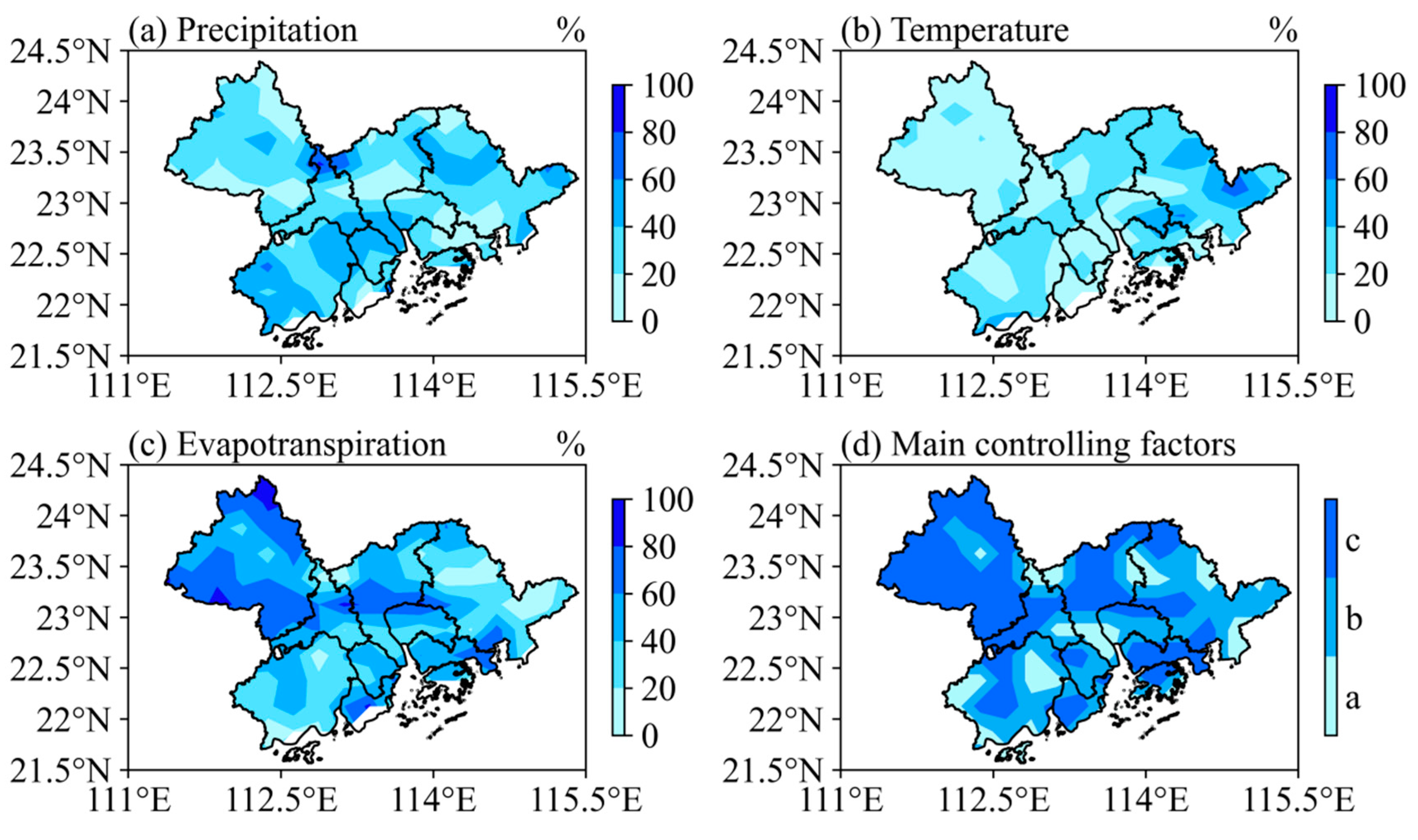
| Test Statistic | CLM5.0 with ESACCI Data | CLM5.0 with In Situ SM Data |
|---|---|---|
| MSE | 0.002 | 0.01 |
| R | 0.81 | 0.89 |
| TSS | 0.58 | 0.29 |
Disclaimer/Publisher’s Note: The statements, opinions and data contained in all publications are solely those of the individual author(s) and contributor(s) and not of MDPI and/or the editor(s). MDPI and/or the editor(s) disclaim responsibility for any injury to people or property resulting from any ideas, methods, instructions or products referred to in the content. |
© 2023 by the authors. Licensee MDPI, Basel, Switzerland. This article is an open access article distributed under the terms and conditions of the Creative Commons Attribution (CC BY) license (https://creativecommons.org/licenses/by/4.0/).
Share and Cite
Huang, Q.; Wang, L.; Jia, B.; Lai, X.; Peng, Q. Impact of Climate Change on the Spatio-Temporal Variation in Groundwater Storage in the Guangdong–Hong Kong–Macao Greater Bay Area. Sustainability 2023, 15, 10776. https://doi.org/10.3390/su151410776
Huang Q, Wang L, Jia B, Lai X, Peng Q. Impact of Climate Change on the Spatio-Temporal Variation in Groundwater Storage in the Guangdong–Hong Kong–Macao Greater Bay Area. Sustainability. 2023; 15(14):10776. https://doi.org/10.3390/su151410776
Chicago/Turabian StyleHuang, Qifeng, Longhuan Wang, Binghao Jia, Xin Lai, and Qing Peng. 2023. "Impact of Climate Change on the Spatio-Temporal Variation in Groundwater Storage in the Guangdong–Hong Kong–Macao Greater Bay Area" Sustainability 15, no. 14: 10776. https://doi.org/10.3390/su151410776
APA StyleHuang, Q., Wang, L., Jia, B., Lai, X., & Peng, Q. (2023). Impact of Climate Change on the Spatio-Temporal Variation in Groundwater Storage in the Guangdong–Hong Kong–Macao Greater Bay Area. Sustainability, 15(14), 10776. https://doi.org/10.3390/su151410776







